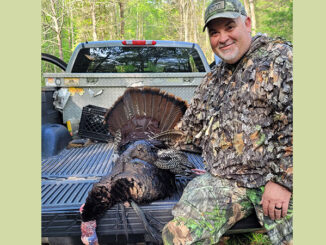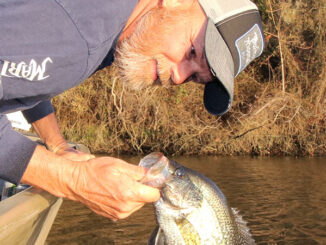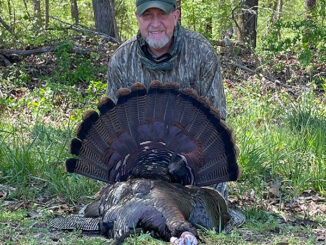
Migration of baitfish into Falls of Neuse Lake’s biggest tributary sets up a great autumn crappie fishery for North Carolina anglers.
In the cool, morning air, Eddie Moody’s passenger boarded the Roxboro guide’s boat and brushed aside the life jacket placed on the seat for him.
“You may not wear it going out, but I bet you’ll wear it coming back,” said Moody, grinning.
The reasoning for his caution became evident as he throttled down and navigated the narrow, hairpin turns, speeding downriver from the boat ramp on the Eno River. Within minutes, they arrived at the spot where Moody had finished the previous day, within sight of the railroad trestle that passes the northern tip of Falls of the Neuse Lake.
Less than 8 miles northeast of downtown Durham, the Eno is a scenic stretch of slow-moving water that time has seemingly passed by. But while the modest river may smack of the timeless traditions spent with grandpa and a cane pole, make no mistake, the stream has depth — despite its lack of breadth — and it’s a hardcore crappie angler’s dream come true in November.
As the most substantial member of the three tributaries that form the Neuse River — the Little and Flat rivers are the other two — the Eno features depths of 20 feet or more. When seasonal dynamics swap summer for fall, the humble river floods with shad clambering up from the shallow, upper reaches of Falls Lake in search of that deeper, more oxygenated water, and Falls’ crappie follow suit.
Although the shad migration may begin as early as September, the largest number of shad will be on hand in November, where those baitfish are found will be the deciding factor in the whereabouts of crappie. High-interest areas such as river bends, contour breaks and woody cover will produce, but the percentage will be much higher near the huge schools of shad.
“The bait was thick as fleas in here yesterday,” said Moody, who runs Slab’s Guide Service.
In spite of his confidence, Moody struggled to mark the masses on his sonar and for a moment appeared concerned. However, he was quickly reassured by the dimpled water that stretched out in front of him, flickering with flipping threadfin shad.
Moody deployed his trolling motor and stood at the stern over a bucket of minnows like a master assembler, attaching them to 2-inch plastic grubs before pitching them behind him and setting the rods in their holders. Running eight rods from the transom, the jigs started from the outside-in with a 1/32-ounce head and alternated with a 1/16-ounce bait. Due to the differences in weight, the baits ran slightly offset from each other, preventing tangling on the turns and creating a greater coverage of the water column.
The outside rods, 10 feet long, ran perpendicular to the gunwales like outriggers. The other rods, 6 to 6½ feet, gradually angled in until the two rods next to the motor ran straight out behind the transom.
Moody trolled the river channel between 0.7 and 0.9 miles per hour, keeping the jigs, which trailed 40 feet behind the boat, at an average depth of 6 to 7 feet in the 15-foot deep water.
“If it gets really cold and the crappie are deep, I’ll slow down until the baits are running a foot or so off the bottom,” Moody said. “That’s why I would rather long-line troll than tight-line, because I can control my depth with my speed. If I catch a fish while I’m making a turn, it tells me what the crappie want. The inside jigs slow down and fall, while the outside jigs speed up and rise. Whichever one gets bit tells me to speed up or slow down.”
Shortly after splitting the bait pod, Moody’s electronics showed significant arches, and the result was bowed rods. If a rod tip showed the slightest trembling, Moody set the hook and passed the rod to his passenger, leaving himself free to set another. Ranging from throwbacks to 12-inchers, the livewell got crowded in a hurry. When the action slowed, Moody made an about-face, and the action started again. In a matter of hours, he managed to put together a catch that filled a cooler.
The decision to long-line troll from the stern or tight-line from the bow is often a matter of preference to the angler. Long-liners can cover more ground, but tight-liners can hover over a school of crappie. Both are deadly, but guide Freddie Sinclair of Clayton, who also fishes the Eno, chooses the latter.
“The Eno is hard to get in with real long rods,” said Sinclair, of Sinclair’s Guide Service. “I’m taking my 10- to 14-foot rods at the longest. But most of the terminal tackle I use is the same as I use at any lake. I like a No. 2 Aberdeen hook for live minnows or a 1/32-ounce jighead with a soft plastic, a ¼-ounce to a ½-ounce egg sinker, and a split shot pinched below it to keep it from sliding down to the hook.”
Sinclair employs eight to 10 rods from the bow and occasionally runs rods from the stern if he has enough anglers to man them. His pace is most likely a .5 miles an hour or less.
“If there’s a lot of bait around, I like to use straight minnows,” he said. “Sometimes there’s so much bait that I like to tip a jig with a minnow to make a little different presentation. I like a dark color because most of the time the water is pretty stained. Dark blue, black or even a brown jig, but pink can be a good color in muddy water, and chartreuse is a go-to color in most any conditions.”
Like Moody, Sinclair’s focus is on finding the baitfish schools.
“I’m looking for river bends and drop-offs, but, just like Jordan Lake or any other lake this time of year, I’m looking for baitfish,” he said. “The crappie sense that winter’s coming, and they’re feeding heavily. I’ve been up there when the top of the water was just covered with baitfish. But other times, you can’t see a thing, and you’ll have to mark them with your depth finder. It depends on the barometric pressure and the cold fronts that push them down.
“The crappie can be found in water anywhere from 8 to 22 feet deep,” Sinclair said. “They’ll usually be in the river channel, but sometimes they’ll be on the flats. You have to have really stable weather conditions, and that’s usually in the mornings. I set my baits to be a foot above where ever I’m marking fish.”
Despite the Eno’s huge harboring of slab crappie, both Moody and Sinclair offer caution concerning the terrain. While a bird’s eye view of the area south of the junction of the Eno and Flat may appear to reveal acres of fishable water off the channel, the area is essentially a floodplain, varying in depth from a couple feet to mere inches, depending on rainfall, and extreme care should be exercised if deviating from the channel.
Also, anglers fishing Falls of Neuse Lake may be tempted to access the river from the main body of the lake. While it is possible, the lake is treacherously shallow north of Cheek Road, making access safer and faster by taking out and trailing to the Eno River boat launch.
From the launch, anglers can travel upriver to the Red Mill Road bridge and find more miles of fishable water downriver to the railroad trestle, as well as deeper water into the mouth of the Flat River.
DESTINATION INFORMATION
HOW TO GET THERE — The Eno River has one public access point, an N.C. Wildlife Resources Commission ramp on Rodolphe Road off Red Mill Road in Durham. Access Red Mill Road from I-85.
WHEN TO GO — Baitfish from Falls of Neuse Lake will begin moving in the Eno River in September. This causes some crappie to move in from the lake, joining the river’s population of resident fish, resulting in good fishing. The action only gets better through October and peaks in November when the river is filled with shad. December will see a decline if colder weather ensues.
BEST TECHNIQUES — The most efficient way to take Eno River crappie is either long-line trolling or tight-lining. Long-line trollers present a spread of typically eight rods, pulling 1/16- to 1/32-ounce jigs, jigs with minnows and bladed jigs about 40 feet behind the boat. Keeping baits slightly above the crappie seen on your depth finder is a matter of adjusting speed, usually ranging from a .5 to around 1 mile per hour. Tight-liners will present minnows, jigs or a combination of the two vertically on a spread of reds. A ¼- to a ½-ounce egg sinker resting on a split shot is required to keep the baits vertical; speed varies from a .5 miles an hour to sitting still. The best jig colors for the generally stained waters are dark blue, black, brown, chartreuse and pink. Crucial to success is finding the baitfish. Locating ambush areas such as river bends, woody cover, or dropoffs within that area will sweeten the pot.
FISHING INFO/GUIDES — Eddie Moody, Slab’s Guide Service, 336-583-0098; Freddie Sinclair, Sinclair’s Guide Service, 919-553-4547; See also Guides and Charters in Classifieds.
ACCOMMODATIONS — Eno Cottage Guest House, Durham, 919-236-3879, www.enocottage.com; Scottish Inn, Durham, 919-383-2561; Greater Durham Chamber of Commerce, www.durhamchamber.org.
MAPS — Delorme’s North Carolina Atlas and Gazetteer, 207-846-7000, www.delorme.com; Fishing Hot Spots Maps, 800-All-Maps, www.fishinghotspots.com.







